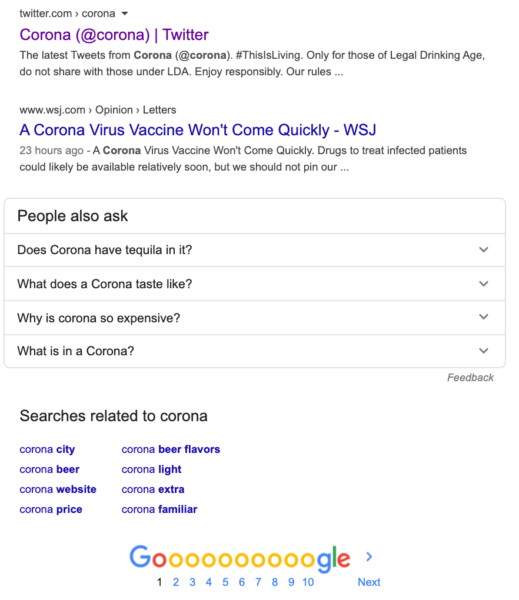Just a few months ago, the term “corona” was typically associated with the Mexican beer brand. Then the novel coronavirus arrived. Over the past month, Google’s search results page for “corona” has transformed significantly into a resource destination for COVID-19-related information.
We have charted the evolution of the Google search results page for “corona” between February 25 and March 23 as the coronavirus spread rapidly across the globe.
February 25. On this date, the earliest snapshot available from the Wayback Machine, a map of Corona, California appeared above the top stories carousel and the Wikipedia page for the city was the third organic listing.

The beer brand was featured in the knowledge panel for the query and owned the top two organic listings. Its Wikipedia page was listed fourth, and the “People also ask” box and “Searches related to” section both pertained to the beverage brand. The company’s Twitter account showed in the eighth organic listing.

COVID-19-related articles had begun appearing in the top stories carousel and as the sixth, seventh and ninth organic results.
March 2. The snapshot below, taken six days later, shows a COVID-19 SOS alert at the top of the results. The right-sidebar knowledge panel was gone, and a “Help and information” and “Safety tips” box appeared between the top stories and organic listings.

The beer brand’s websites were still in the top two organic results, and its Wikipedia page moved up one slot to the third result. Its Twitter account had also moved up to position six; however, the “People also ask” box disappeared entirely.
The three organic results and two top stories carousel articles related to the outbreak mention the virus with regards to its impact on the beer brand.
Aside from the city’s website (the eighth organic result), results related to Corona, California no longer appeared on the first page.
March 9. The entire top stories carousel once again consisted of virus-related articles.

At this point, there were two organic results related to the virus (without mention its impact on the beer brand). The Californian city and beer brand’s official sites maintained similar visibility compared to March 2. The “Searches related to” section at the bottom of the page still showed eight beer-related search suggestions.
March 20. The SOS alert was removed, but a tabbed COVID-19 Alert section (highlighted in red) began appearing on the right sidebar. The tabs included symptoms, prevention, treatments and an overview section with the “Help and information” box inside it.

Virus-related content (without mention of the beer brand) took up four of the nine organic results. An expandable “Common questions” box regarding the virus was also showing between the third and fourth listings.
The beer brand’s websites were the number one and number four listings; however, its Twitter account and Wikipedia page, along with sites related to the California city, no longer appeared on the first page. The “Searches related to” section also disappeared.

A “See results about” box began appearing below the COVID-19 Alert section. Clicking on the box took users to the search results for “Corona (beer).”
March 23. The COVID-19 Alert section moved to the left side of the page and a statistics tab was added to it. Selecting a tab now filtered the main search results column, instead of displaying information in the COVID-19 Alert section as it previously did.

On the right-hand side of the results page, Google began showing a statistics module. Both the statistics and alert section are part of Google’s expanded COVID-19 search experience, which was announced Saturday. Clicking on “More statistics” took users to Google’s coronavirus map, which displays the number of confirmed, recovered and fatal cases, as well as cases per one million people, filtered by geographic region, much like Bing’s COVID-19 tracker.
The top two organic results were from the World Health Organization and the New York Times. The third listing was Worldometer’s COVID-19 tracker, which displays statistics for the virus. The rest of the organic results appeared towards the bottom of the page, below the top stories carousel, “Help and information” box, the top three organic results, a “Prevention” box, a “Local and health authorities on Twitter” carousel and the common questions section.
The beer brand’s two sites, Merriam-Webster’s “corona” definition page, the “corona” Wiktionary page, gardening equipment company Corona Tools and a Washington Post article on the virus rounded out the remainder of the organic listings.
More coronavirus-related coverage
COVID-19 has caused brands in all industries to shift the way they do business. Here are a few recent articles to help you adapt:
- COVID-19 checklist for businesses: How to manage your online presence and keep customers updated in a time of crisis
- Bing adopts SpecialAnnouncement structured data for COVID-19
- A look at Google’s recent COVID-19 related policies in search
- Nextdoor rolls out Groups and Help Map in response to coronavirus outbreak
- Coronavirus: Emarketer lowers global ad spend projections for 2020
- Yelp sees huge decline in restaurant demand, offers $25MM relief package
The post Corona to COVID: How Google’s ‘corona’ results page has evolved appeared first on Search Engine Land.
source https://searchengineland.com/corona-to-covid-how-googles-corona-results-page-has-evolved-331245

0 Comments